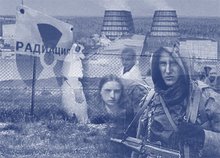 Nuclear Security Culture: From National Best Practices to International Standards
Nuclear Security Culture: From National Best Practices to International Standards Volume 28 NATO Security through Science Series: Human and Societal Dynamics
Edited by: I. Khripunov, N. Ischenko and J. Holmes
September 2007, approx. 168 pp., hardcover
ISBN: 978-1-58603-786-4 NEW
Over the past several years, the International Atomic Energy Agency (IAEA) has been working on a definition of ‘nuclear security culture’ so that it can be used as a tool to improve the physical protection of nuclear materials and facilities. A 2001 IAEA report titled ‘Fundamental Principles of Physical Protection of Nuclear Materials and Nuclear Facilities’ identified security culture as one of the twelve principles underlying fissile-material security. In February 2005, at a summit in Bratislava, President Bush and President Putin vowed to step up joint efforts to bolster nuclear security, pairing disciplined, well-trained, responsible custodians and protective forces with well-maintained security systems. In July 2005, a series of amendments to the Physical Protection Convention was approved elevating the status of security culture to that of a treaty obligation. Since that time, IAEA member states worked on a concept, definition and guidelines for developing and implementing a robust security culture at nuclear facilities worldwide. This NATO workshop presents the views of experts with the hope to contribute to the IAEA’s work and facilitate nuclear security culture worldwide better. Issues include: Universality of nuclear security cultures; Nuclear security in a nation’s culture; Differences and similarities between regions such as US, European Union, Japan, etc.; and The advantages of similarities between the regions.
IOS Press
Nieuwe Hemweg 6B, 1013 BG Amsterdam, The Netherlands
Tel.: +31 20 688 3355, Fax: +31 20 687 0039
E-mail: info@iospress.nl
 Social and Psychological Effects of Radiological Terrorism
Social and Psychological Effects of Radiological Terrorism Volume 29 NATO Security through Science Series: Human and Societal Dynamics
Edited by: I. Khripunov, L. Bolshov and D. Nikonov
October 2007, approx. 176 pp., hardcover
ISBN: 978-1-58603-787-1 NEW
The threat of radiological terrorism has recently come to the attention of the international community, as it became clear that terrorist organizations are seeking nuclear and radiological material to manufacture and use improvised nuclear devices (IND) and ‘dirty bombs’, and/or commit acts of sabotage against nuclear power infrastructure. But while nuclear weapons and INDs, still remain relatively secure from terrorist access, radiological material is more readily available in large quantities throughout the world. Also, radiological explosives or other dispersal devices are easier to manufacture and to use. Radiological dispersal devices (RDDs) come in many shapes and sizes; A dirty bomb uses a conventional explosion to scatter radioactive material; Terrorists could launch an attack by placing a container of radioactive material in a public place and an airplane can easily disperse radioactive material as a powder or an aerosol. On a grand scale, a nuclear facility could become an RDD. Intentional damage done to a nuclear power plant or other site could release radiation, contaminating the immediate surroundings or even beyond. RDDs of any kind present a potent and effective terrorist weapon because they threaten to expose civilian populaces to radiation – engendering panic out of proportion to the modest number of casualties likely to result from limited doses of radiation. Coming to terms with the psychological and social dimensions of radiological attacks – areas that are inadequately studied and assessed – is thus a matter of considerable importance for those entrusted with national, and ultimately international, security.
IOS Press
Nieuwe Hemweg 6B, 1013 BG Amsterdam, The Netherlands
Tel.: +31 20 688 3355, Fax: +31 20 687 0039
E-mail: info@iospress.nl

